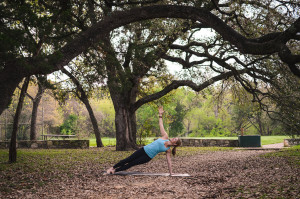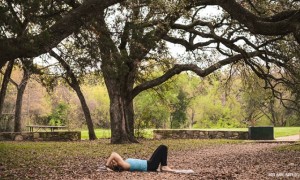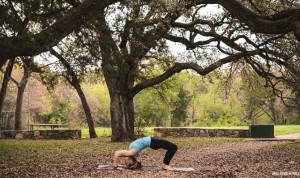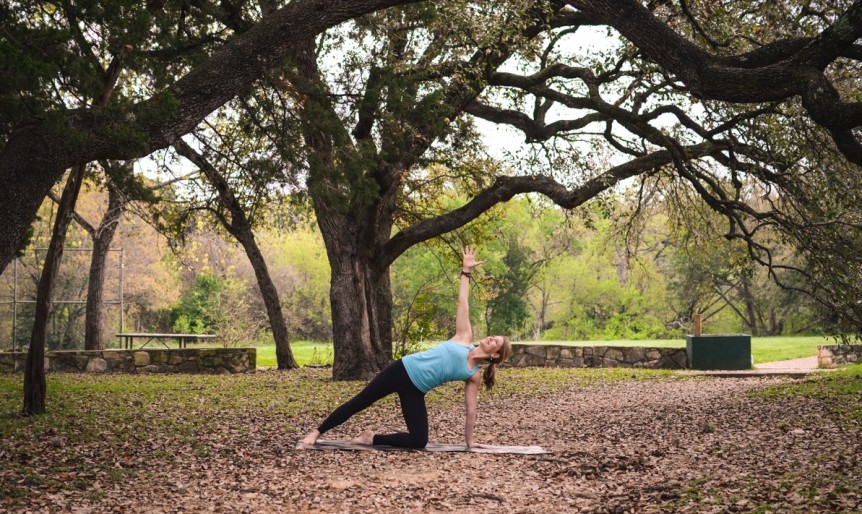Featured on YogaJournal.com
“Spring cleaning” doesn’t just mean tidying up your house. Each year, the new energy of spring and extra daylight inspire me to fine-tune my practice on the mat. By taking a fresh look at some foundational poses, we can clean up our alignment and generate even more energy. Here are a few common mistakes or “defaults” that I often see in my classes, plus some simple modifications and adjustments to create greater alignment and total-body integration.
1. Downward-Facing Dog

Correct Alignment
Plant your hands shoulder-distance apart or wider at the top of your mat, spread your fingers, and root down through your knuckles. Lift your hips high and step your feet to the back of the mat. Separate your feet hip-distance apart and point them to 12 o’clock. Ground down through all four corners of your feet and press your heels toward the mat. From the skin to the muscle to the bone, hug in, and firm your legs and arms. Set your drishti (gaze) between your ankles.

Default: Short Dog
When your stance is too short, Downward-Facing Dog can feel tight and constrained, especially through the shoulders, low back, and wrists.

Adjustment: Create more space
Open up your base and widen your hands and feet to access more power, freedom, and equanimity. Step your feet back and hands forward to create more space in your pose. Press your knuckles firmly into the mat, bend your knees deeply, and lengthen your spine. With your back full and open, start to straighten your legs and work your heels toward the mat.
2. Chaturanga

Correct Alignment
From Plank, melt your thoracic spine (upper and middle back) in and broaden across your chest. Lift your gaze to the top of your mat, press forward to your toes, and lower your arms to 90 degrees with your elbows directly over your wrists. Lengthen your tailbone toward your heels and firm your leg muscles.

Default: Shoulders forward, bottom up.
Shoulders often round forward and collapse in Chaturanga, and your bottom goes up. This disintegrates the upper and lower halves of the body, you lose power, and it puts tremendous pressure on the shoulders and rotator cuff.

Modification: Bring your knees down
Bring your knees down to the mat. Keep your chest broad and open and your side body long. Lengthen your tailbone down and lift your low belly up and in. With your whole body working as one unit, lower down to a modified Chaturanga at 90 degrees.
3. Upward-Facing Dog

Correct Alignment
Press your palms to the floor at the top of your mat, shoulder-distance apart, and the tops of your feet to the back of your mat at hip-distance apart. Engage your quadriceps and abdomen to lift the front of your thighs off the mat, and spin your inner thighs toward the sky. Stack your shoulders over your wrists and soften your elbows slightly. Root down through the triads of your hands, draw your upper arm bones back, and lift and open across your chest.

Default: Shoulders forward, thighs on ground
If your shoulders are rounding forward and thighs are on the ground, Upward-Facing Dog can feel tight and constricted rather than open and expansive.

Adjustment: Bend your elbows and lift your thighs
Ground down through your knuckles and bend your elbows. With your elbows bent you can access and move the heads of your upper arm bones onto your back. Broaden across your chest. Press the tops of your feet down, hug your outer shins in, and lift your thighs up off the mat. Press your hands down, straighten your arms, lift your gaze, and come into your full expression.
4. Side Plank

Correct Alignment
Ground down through your lower hand and lift your opposite arm to the sky. Press the outer edge of your lower foot into the floor and stack your upper foot on top. Flex both feet, spread your toes, and hug your leg muscles to the bones. Press your tailbone toward your heels and lift the pit of your belly up and in to build your inner fire. Look to your top hand and spread your fingers wide. Lift your hips as high as you can and open your chest as you expand from the inside out.

Default: Inactive feet
If your feet are inactive in Side Plank, you are depending heavily on your arm and core strength to keep your whole body lifted. Feet create the foundation of the pose and integration of your legs with your core.

Modification: Drop one knee
Bring your bottom knee to the mat, directly under your hip. Press down into the ground the through all four corners of your top foot, engage your top leg, and stack your hips. For more support as you set your foundation, bring your top hand to your top hip. When you are set, reach the crown of your head long and extend your top hand to the sky.
5. Crescent Lunge

Correct Alignment
With a long stance on your mat, ground down into all four corners of your front foot. Stack your back heel over the ball of your back foot and hug skin to muscle and muscle to bone. Bend your front knee to 90 degrees and align your front knee over your ankle. Hug your inner thighs toward one another and square both hips to the front of the mat. Lift your arms and chest high. Lift your low belly and scissor your inner thighs in toward your centerline.

Default: Back heel is pressing back
With your back heel pressed toward the back of the mat, your back leg works independently from your body. This results in loss of overall power and ability to hug into the centerline.

Modification: Drop your back knee
Drop your back knee. Bringing your back knee down can help to build strength and stability with your leg, and build core strength and integration.
6. Wheel Pose

Correct Alignment
Lie down on your back, bend your knees, and place your feet hip-distance apart and facing 12 o’clock. Plug into the earth with your feet and stack your knees over your ankles. Set your hands over your shoulders by your ears, wider than your shoulders, with your fingers facing back toward your body. With an inhale, press up to the crown of your head, and draw your shoulders onto your back. With your next inhale, press into your foundation and lift up off the ground.

Default: Base is too wide
When your base is too wide in Wheel, it can feel like you are barely hanging on. There is an opportunity for more power and integration by shortening your base.


Adjustment: Better shoulder integration
Move your hands closer to your shoulders and wider than your shoulders in the set up on your back. With your first inhale, come to the crown of your head and integrate your shoulders. Move your elbows in toward your body, and hug your shoulder blades onto your back. With this shoulder integration, press up into full Wheel Pose.
Read the full article at YogaJournal.com.
